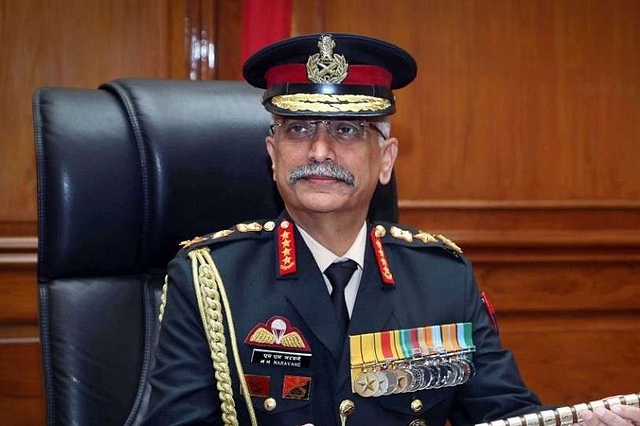
This Is How Army Chief’s Nepal Visit Will Mark Modi Government’s New Approach To Conducting Foreign Affairs
The visit by General Manoj Mukund Naravane to Nepal marks a new approach by India to neighbourhood diplomacy.
Army Chief General Manoj Mukund Naravane’s visit to Nepal early next month will not only mark a resumption of ties between the two countries after months of chill, but also a new ‘out-of-the-box’ approach in conduct of foreign affairs by the Narendra Modi government.
The choice of the Army Chief as the first top Indian official to visit Nepal after months of diplomatic standoff is highly significant.
Naravane will be conferred the honorary title of ‘General of the Nepal Army’ by Nepal’s President Bidya Devi Bhandari in keeping with a 70-year-old tradition under which the Nepal Army chief is also similarly honoured by India.
But that investiture ceremony is just one engagement in the Army Chief’s Nepal itinerary. He will hold talks not only with his Nepal counterpart, General Purna Chandra Thapa, but also Defence Minister Ishwar Pokhrel.
General Naravane is also likely to call on Nepal Prime Minister Khadga Prasad Sharma Oli. Oli has been a strong critic of India and has led the charge that India had encroached into Nepal’s territory in Uttarakhand (Lipulekh, Limpiyadhura and Kalapani).
The primary agenda for the Indian Army Chief during his three-day visit to Nepal is to strengthen military ties between the two countries. But, say mandarins at South Block (which houses the Ministry of External Affairs), a few other important issues relating to security are also likely to be discussed.
“This (sending the Army Chief to Nepal) is an out-of-the-box approach in conduct of foreign relations. It must be kept in mind that the Army Chief’s comment that Nepal was ‘acting at someone’s behest’ (in objecting to India’s construction of a road to Lipulekh) had triggered strong reactions in Nepal,” said a former envoy to Nepal.
The Border Dispute
The inauguration of a 75.5-kilometre road from Ghatiabgarh to Lipulekh pass (at the trijunction of India, Nepal and Chinese-occupied Tibet) by Defence Minister Rajnath Singh on 8 May had triggered a huge row between the two countries.
Nepal asserted that the road had been constructed in its territory and went on to lay claim to the entire Kalapani area, Lipulekh and Limpiyadhura in the northeastern part of Uttarakhand.
Speaking at a webinar a few days later, General Navarane said that Nepal seemed to be acting “at the behest of someone else” (meaning China) while laying claim to those areas in Uttarakhand.
The Army Chief’s remark drew strong reactions from Nepal’s President Bhandari and Defence Minister Pokhrel.
Nepal then went on to issue a new map that showed Lipulekh, Limpiyadhura and Kalapani within its territory. Nepal also amended its Constitution to incorporate the new map in the country’s national emblem.
That was followed by many intemperate remarks like the Indian coronavirus is more lethal than Chinese and that Bhagwan Ram was born in Nepal.
The Thaw
After months of jingoism, Oli attempted to mend fences with a call to Prime Minister Modi on the eve of Independence Day.
That was followed by a meeting between Nepal’s foreign secretary and India’s ambassador to Nepal to review progress of India-aided projects in that country.
There have been back-channel talks between the two countries since then, but New Delhi is yet to concede to Nepal’s request for foreign secretary-level talks to resolve the border disputes between the two countries.
After the political crisis that Oli faced blew over last month, he also put the brakes on his jingoism and has since then desisted from riling India with intemperate remarks.
Significance Of The Army Chief’s Visit
It is in the backdrop of all these developments over the past few months that the visit of General Naravane assumes significance and marks a milestone in New Delhi’s conduct of foreign relations.
The Army Chief, it may be recalled, had also visited Myanmar along with foreign secretary Harsh Vardhan Shringla earlier this month. That visit, too, marked a new approach by India to neighbourhood diplomacy (read this).
The visit by the general to Nepal is a continuation of this new approach, say foreign affairs analysts.
The US and some other Western powers have been practising this for some time now; three and four-star generals of those countries occasionally undertake quasi-diplomatic missions.
“There are many advantages in such an approach. First, it sends out a strong message to that country. The optics are also very good: our Army Chief in full military regalia visiting and meeting top leaders of another country looks good and enhances the image of India,” said a joint secretary-ranked officer in South Block.
“Security and strategic affairs are important cornerstones (along with economic ties) of our overall foreign policy and so it is apt to send the Army Chief to a country to which a strong message needs to be conveyed,” the officer added.
But implementing this new approach wasn’t easy because there was a bit of pushback from a section of the IFS lobby which viewed foreign policy and its conduct as its exclusive domain.
However, with External Affairs Minister S Jaishankar spearheading this new approach, and the minister having been the foreign secretary himself, the South Block mandarins who led the pushback soon fell in line.
MEA officials say that deputing the service chiefs, especially the army and navy chiefs, on quasi-diplomatic missions to other countries will become standard practice soon.